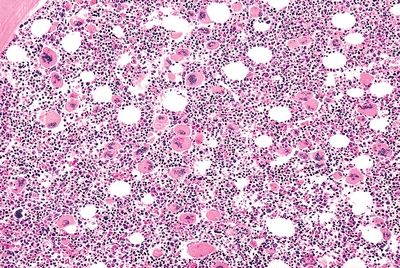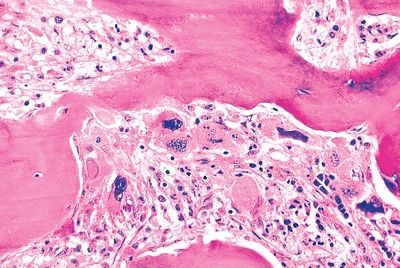QUESTION 16.1
A. Acute leukemia
B. Blood loss
C. Bone marrow transplantation following normalization of blood counts
D. Ineffective hematopoiesis
E. Pancytopenia
2. The microscopic findings of a bone marrow biopsy from a 40-year-old patient with AIDS are shown in this photomicrograph. Besides AIDS, this characteristic change is associated most commonly with:
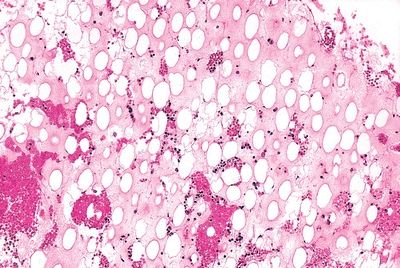
QUESTION 16.2
A. Bone marrow transplantation
B. Cachexia
C. Drug toxicity
D. Parvovirus B19 infection
E. Rheumatoid arthritis
3. A trephine biopsy shows entirely necrotic tissue. Which of the following conditions is the most frequent cause of necrosis in bone marrow biopsies?

QUESTION 16.4
A. Hodgkin lymphoma
B. Metastatic disease
C. Myelofibrosis
D. Non-Hodgkin lymphoma
E. Sickle cell anemia
4. A bone marrow biopsy from a 30-year-old male with fever of unknown origin reveals several lesions such as the one shown in this photomicrograph. Culture studies and special stains for infectious organisms are carried out. The most common etiology of such lesions in bone marrow biopsies is:
A. Idiopathic: no apparent etiology
B. Infectious: fungal or mycobacterial
C. Non-Hodgkin or Hodgkin lymphomas
D. Q fever
E. Sarcoidosis
5. A bone marrow biopsy from an AIDS patients presenting with severe anemia and reticulocytopenia reveals intranuclear inclusions in numerous erythroid precursors, as shown in this photomicrograph. Which of the following is the infectious agent?
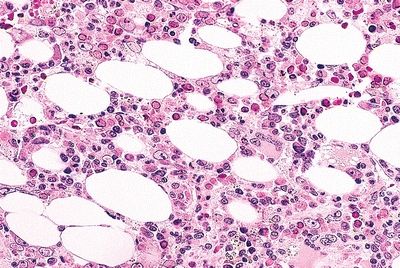
QUESTION 16.5
A. Cryptococcus neoformans
B. Cytomegalovirus
C. Herpesvirus
D. Mycobacterium avium–intracellulare
E. Parvovirus B19
6. A bone marrow biopsy is performed in a patient with clinical and hematologic findings suggestive of acute leukemia. Which of the following morphologic features allows distinguishing acute myeloid leukemia (AML) from acute lymphocytic leukemia (ALL)?
A. Auer rods
B. Blast size
C. Chromatin pattern
D. Cytoplasmic features
E. Presence and number of nucleoli
7. Which of the following studies provides the most important prognostic indicators in acute leukemias?
A. Cytochemistry
B. Cytogenetics
C. Immunophenotyping
D. Molecular analysis
E. Morphology
8. Which of the following are the chemotherapeutic compounds that most frequently cause acute leukemias?
A. Alkylating agents and topoisomerase II inhibitors
B. Anthracyclines like daunorubicin
C. Antimetabolites like 5-fluorouracil
D. l-Asparaginase
E. Mitotic inhibitors like vincristine
9. A 58-year-old male undergoes bone marrow examination because of blood cytopenia without apparent cause. The bone marrow is hypercellular with an increased number of myeloid precursors and marked erythroid hyperplasia. Clusters of immature myeloid precursors are seen in an abnormal location, far from bone trabeculae. Which of the following is the most likely diagnosis?
A. Chronic idiopathic myelofibrosis
B. Chronic myeloid leukemia
C. Essential thrombocythemia
D. Myelodysplastic syndrome
E. Polycythemia vera
A. Chronic myeloid leukemia
B. Essential thrombocythemia
C. Polycythemia vera
D. Primary myelofibrosis
E. Secondary erythrocytosis
A. Chronic myeloid leukemia
B. Essential thrombocythemia
C. Polycythemia vera
D. Primary myelofibrosis
E. Secondary erythrocytosis
A. Chronic myeloid leukemia
B. Essential thrombocythemia
C. Mastocytosis
D. Polycythemia vera
E. Primary myelofibrosis
13. Systemic mast cell disease is clinically suspected in a 67-year-old female patient. A bone marrow biopsy reveals multiple foci of abnormal cell infiltrates such as the one shown in this high-power picture. Which of the following special techniques is most useful to confirm bone marrow involvement by mast cell disease?
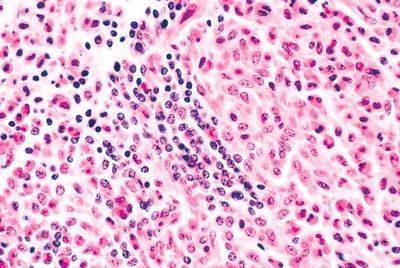
QUESTION 16.13
A. CD1a immunohistochemistry
B. Myeloperoxidase histochemistry
C. Tartrate-resistant acid phosphatase (TRAP) histochemistry
D. Tryptase immunohistochemistry
E. Ultrastructural studies
14. A bone marrow biopsy is performed for staging of a non-Hodgkin lymphoma (NHL). Histologic examination reveals a focal paratrabecular pattern of marrow involvement. This pattern is most consistent with:
A. Burkitt lymphoma
B. Follicular lymphoma
C. Hepatosplenic T-cell lymphoma
D. Mantle cell lymphoma
E. Small lymphocytic lymphoma/chronic lymphocytic leukemia
15. With respect to evaluation of bone marrow involvement by Hodgkin lymphoma (HL), which of the following is correct?
Stay updated, free articles. Join our Telegram channel

Full access? Get Clinical Tree



